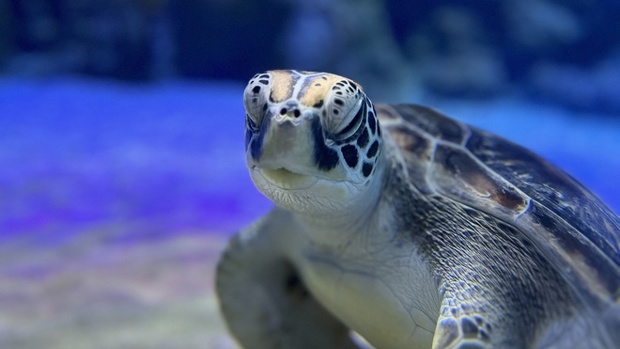Green turtle ‘Smee’ returned to ocean near Tauranga after 11 months rehab at Kelly Tarlton’s
- Publish Date
- Wednesday, 8 March 2023, 8:09AM

A “cheeky” green turtle has been released after 11 months of rehabilitation.
Smee, named after Captain Hook’s first mate, was accidentally hooked by a fisherman off the Ōmokoroa coast last year.
Smee was initially triaged by a team at Auckland Zoo who found he had swallowed a second fishing hook.
Both hooks were removed and Smee’s health improved at Sea Life Kelly Tarlton’s Turtle Rehabilitation Centre before staff released him back into the ocean off Tauranga on Monday.
The moment was bittersweet for the staff but lead turtle rehabilitator Tyler Hall said the other turtles “probably breathed a sigh of relief”.
“He was a hungry boy and cheeky. He was always knocking things over and trying to get in the way of other turtles trying to get to their food.
“He was the big guy in the tank. The other turtles are more reserved and not keen to get in your face.
“When we were diving, Smee was coming over and checking what we were up to when the others mind their own business.”
Most of the turtles in the centre have been affected by humans in some way, including boat strikes, fishing hooks, plastic ingestion or habitat destruction.
Smee grew from 11.5 kilograms to 19kg while under the care of the team.

The rescue, rehabilitation and release of sick and injured sea turtles was a collaborative effort from Team Turtle, which includes Sea Life Kelly Tarlton’s, the Department of Conservation, Auckland Zoo and iwi.
It would be releasing more sea turtles into the ocean over the next couple of months.
Hall encouraged people to report injured or stranded turtles to the DOC emergency hotline on 0800 362 468.
“Explain to them what you found and they’ll send someone out there right away.
“Don’t attempt to put it back because usually if these things have happened it’s for a specific reason. It’s better to find out what’s wrong, look after them and send them on their way when the time is right.”
It was hoped Smee would not be seen again but if he did find himself in trouble, Hall said, like other rescued turtles, he had flipper tags put on and was microchipped.
The microchip was the same as those that go into dogs or cats and was a way to identify Smee if something happened to his tags.
GPS tags were not used because they were expensive and invasive, Hall said.
Although turtles breed in the tropics and subtropics, five species were seen in New Zealand waters.
Greens and leatherbacks were the most common, and others were loggerheads, hawksbills and olive ridleys, according to the DoC website.
Green turtles feed mostly on seagrasses, algae and mangroves. They also eat fish and their eggs, jellyfish, sponges and various shellfish.
They are called green turtles because of the colour of their meat when made into soup.
The International Union for Conservation of Nature (IUCN) lists green turtles as endangered.
This article was first published by the NZ Herald and is republished here with permission.
Take your Radio, Podcasts and Music with you

